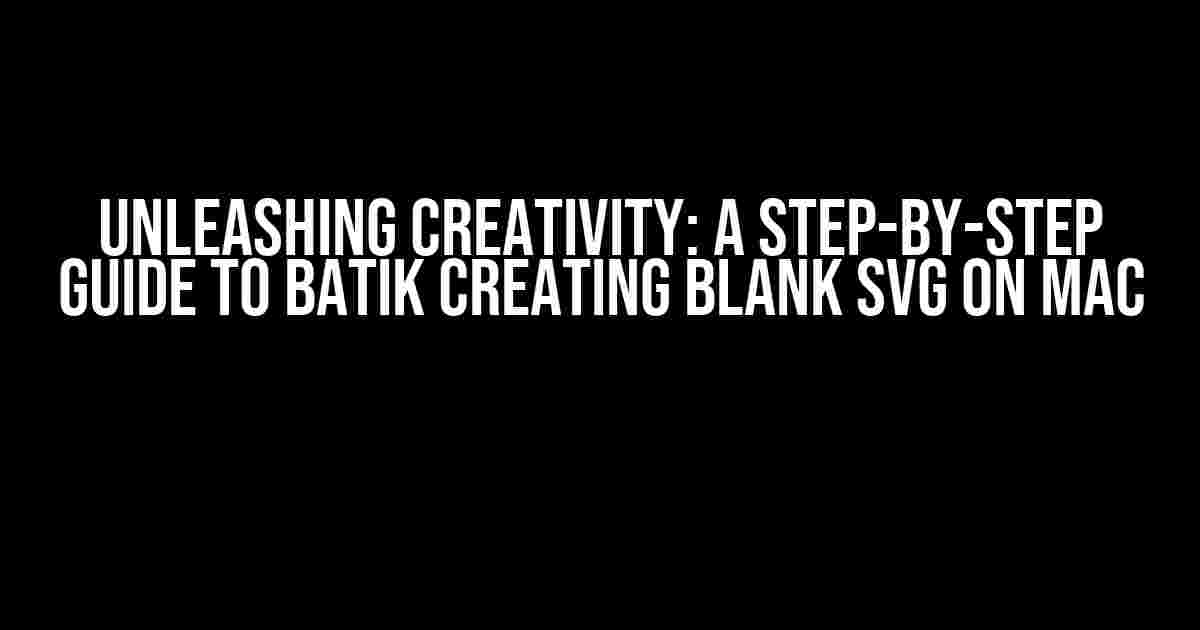Are you a Mac user eager to dive into the world of Batik and create stunning vector graphics? Look no further! In this comprehensive guide, we’ll walk you through the process of creating a blank SVG file on your Mac, tailored specifically for Batik enthusiasts.
- What is Batik?
- Why Create a Blank SVG File?
- Required Tools and Software
- Step 1: Create a New Text File
- Step 2: Add the SVG Namespace
- Step 3: Define the SVG Structure
- Step 4: Save and Close the File
- Step 5: Open the SVG File in a SVG Editor
- Step 6: Create Your Batik Design
- Step 7: Save Your Design as an SVG File
- Step 8: Run Batik Commands
- Common Batik Commands
- Conclusion
- Additional Resources
What is Batik?
Before we dive into the tutorial, let’s take a brief moment to understand what Batik is. Batik is an open-source library for creating and manipulating Scalable Vector Graphics (SVG) files. It’s a powerful tool for designers, developers, and artists alike, offering a wide range of features for creating complex vector graphics. With Batik, you can create intricate patterns, logos, icons, and more.
Why Create a Blank SVG File?
Creating a blank SVG file is an essential step in Batik creation, as it provides a clean slate for your artistic expression. By starting with a blank SVG file, you can:
- Design from scratch, without any pre-existing elements
- Have complete control over the structure and organization of your file
- Optimize your file for performance and compatibility
Required Tools and Software
To follow along with this tutorial, you’ll need the following tools and software on your Mac:
- A text editor or code editor (e.g., TextEdit, Visual Studio Code, or Sublime Text)
- A SVG editor (e.g., Adobe Illustrator, Inkscape, or Affinity Designer)
- Terminal or Command Prompt (for running Batik commands)
Step 1: Create a New Text File
Open your preferred text editor or code editor and create a new file. Save this file with a `.svg` extension, for example, `blank_svg.svg`. This file will serve as the foundation for your Batik creation.
<?xml version="1.0" encoding="UTF-8" standalone="no"?>
Copy and paste the above code into your new file. This line of code declares the document type and encoding for your SVG file.
Step 2: Add the SVG Namespace
Next, add the SVG namespace declaration to your file:
<svg width="100%" height="100%" version="1.1" xmlns="http://www.w3.org/2000/svg">
This line of code defines the SVG namespace and sets the document dimensions to 100% width and height.
Step 3: Define the SVG Structure
Add the following code to create the basic structure of your SVG file:
<svg> <defs></defs> <g></g> </svg>
This code defines the SVG element, followed by a `defs` element for defining reusable elements, and a `g` element for grouping shapes and other elements.
Step 4: Save and Close the File
Save your file and close the text editor or code editor. You now have a blank SVG file ready for Batik creation.
Step 5: Open the SVG File in a SVG Editor
Launch your preferred SVG editor (e.g., Adobe Illustrator, Inkscape, or Affinity Designer) and open the `blank_svg.svg` file you created earlier. You should see a blank canvas waiting for your creative touch.
Step 6: Create Your Batik Design
Using your SVG editor, start creating your Batik design. You can draw shapes, paths, and curves to form intricate patterns and designs. Don’t worry too much about the details at this stage – focus on getting your ideas down, and refine them later.
Step 7: Save Your Design as an SVG File
Once you’re satisfied with your design, save it as an SVG file. Make sure to choose “Save As” and select the SVG format to preserve the vector data.
Step 8: Run Batik Commands
Open Terminal or Command Prompt on your Mac and navigate to the directory where you saved your SVG file. Run the following Batik command to optimize and validate your SVG file:
batik -validate -o output.svg input.svg
This command will validate your SVG file and save the optimized version as `output.svg`.
Common Batik Commands
Here are some common Batik commands you might find useful:
| Command | Description |
|---|---|
| batik -h | Displays help and usage information |
| batik -validate input.svg | Validates the input SVG file |
| batik -o output.svg input.svg | Optimizes and saves the input SVG file as output.svg |
| batik -pretty input.svg | Prettifies the input SVG file, making it more human-readable |
Conclusion
Congratulations! You’ve successfully created a blank SVG file on your Mac, tailored for Batik creation. By following these steps, you’ve taken the first step in unleashing your creativity with Batik. Remember to experiment, explore, and push the boundaries of what’s possible with this powerful tool.
Happy creating!
Additional Resources
Want to learn more about Batik and SVG creation? Check out these additional resources:
- Batik Official Documentation:
https://xmlgraphics.apache.org/batik - SVG Tutorial by Mozilla:
https://developer.mozilla.org/en-US/docs/Web/SVG/Tutorial - SVG Editor Comparison:
https://www.svg-editor.com/comparison
Stay creative, and don’t hesitate to reach out if you have any questions or need further guidance!
Frequently Asked Question
Get ready to unleash your creativity and bring your batik designs to life! Here are some frequently asked questions about creating a blank SVG on a Mac for batik design:
What software do I need to create a blank SVG on my Mac?
You’ll need a vector graphics editor like Adobe Illustrator, Sketch, or Inkscape to create a blank SVG on your Mac. All three options are compatible with Mac OS and offer a free trial or affordable subscription plans.
How do I create a new SVG file from scratch in Adobe Illustrator?
To create a new SVG file in Adobe Illustrator, go to File > New > Profile > Web, and set the dimensions to your desired size. Choose SVG as the format and set the resolution to 72 pixels per inch. Then, click Create to start designing your batik masterpiece!
What are the ideal dimensions for a batik design SVG?
The ideal dimensions for a batik design SVG depend on the intended use, but a good starting point is a square or rectangular shape with a minimum of 1000 x 1000 pixels and a maximum of 5000 x 5000 pixels. This will ensure your design is scalable and detailed enough for printing or digital sharing.
Can I create a batik design SVG using a free online tool?
Yes, you can create a simple batik design SVG using free online tools like Canva, Figma, or Vectr. These tools offer a range of templates, shapes, and design elements to help you create a batik-inspired design. Just keep in mind that the features and functionality may be limited compared to professional vector graphics editors.
How do I save my SVG file to ensure it’s compatible with batik printing software?
To ensure compatibility with batik printing software, save your SVG file in the SVG 1.1 format, which is the most widely supported version. Also, make sure to embed any images or fonts used in your design to avoid any issues during the printing process.




